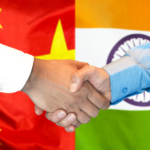A mother upset in northern Nigeria grips her two-year-old toddler. Skin-whitening lotions, he had used to try to lighten his complexion left burns and discolored skin on his face and legs. Under family pressure, the 32-year-old—whose name has been changed to save her identity—used these lotions on all six of her children. She now truly regrets her behavior.
- What follows from skin bleaching?
- Why Are Skin-Whitening Products Particularly Dangerous?
- Why are more parents choosing to have their children's skin blurred?
- How Is It Simple to Purchase Skin-Whitening Creams in Nigeria?
- In what ways are authorities fighting the epidemic?
- Could the Story of Fatima warn other parents?
As we shall call her, Fatima tells us her mother preferred her sister’s lighter-skinned children over her own. “My children are darker-skinned; my sister delivered light-skinned children. It hurt a lot as my mother preferred the children of my sister over mine because of their skin tone.” She hoped using skin-lightening products would help her mother regard her kids differently.
What follows from skin bleaching?
The creams first were working. Her grandmother welcomed her children’s lighter skin. Still, the burns and scars showed soon after. Now, one of her daughters hides her burns by covering her face when she is out. Another daughter changed her skin tone generally and had a pale circle around her eyes. The lips and knees of a third child have pale scars. Her toddler’s younger brother still bears gaping wounds that never seem to heal.
Skin-lightening solutions are rather common in Nigeria. The World Health Organisation (WHO) reports that, among African women, 77% of Nigerian ones routinely use such products. With 66% of women in Congo-Brazzaville, 50% in Senegal, and 39% in Ghana using these creams, the practice is also rather common elsewhere.
Why Are Skin-Whitening Products Particularly Dangerous?
Harmful chemicals, including corticosteroids, hydroquinone, mercury, and kojic acid, abound in many skin whitening treatments. These drugs might induce serious skin ailments, including dermatitis, acne, skin pigmentation, and inflammatory diseases. Long-term use can cause mercury poisoning, kidney damage, and a thinning of the skin, increasing the susceptibility of wounds to infection and slowing their healing.
Acknowledging the seriousness of the problem, Nigeria’s National Agency for Food and Drug Administration and Control (NAFDAC) issued a 2023 state of emergency. The growing number of parents tanning their children’s skin adds to the issue.
Why are more parents choosing to have their children's skin blurred?
According to Abuja’s dermatology spa owner, Zainab Bashir Yau, 80% of the women she has seen either plan to or have bleached their children. “Many people associate light complexion with riches or beauty. Women often protect their children from prejudice by whitening them from delivery,” she says. Many of these women saw it as typical behavior since they were also bleached as newborns.
Lighter skin is sometimes connected in Nigerian society with greater employment possibilities, more marriage possibilities, and even higher social levels. Driven by societal expectations, many women begin whitening their children’s skin from infancy in an attempt to protect them from potential prejudice as those with darker complexion.
In Nigeria, the most obvious indication of skin whitening is the difference between black knuckles and lighter skin. While lightening most of the skin, knuckles usually stay dark. But smokers and drug addicts can also get darkening skin patches, which causes social shame. The sixteen- and fourteen-year-old daughters of Fatima have experienced prejudice since others believe they are drug users. “They all name them as drug addicts and point fingers at them. They have suffered greatly from this, she says. This misunderstanding has caused both females to lose possible fiancés.
How Is It Simple to Purchase Skin-Whitening Creams in Nigeria?
A whole row of stores in a small market in Kano is devoted to providing lighting treatments. Some suppliers manufacture customized creams on demand and identify as “mixologists.” Though many consumers prefer to choose fresh ingredients and have creams prepared before their eyes, pre-mixed variations abound in the stores.
Many of these products—including those aimed at infants—contain controlled drugs. Salespeople came clean about taking large amounts of glutathione, kojic acid, and hydroquinone. When a customer wants a dramatic lightning effect, one vendor claimed he adds “a lot of kojic”—far above the authorized 1% limit stipulated by NAFDAC.
Some ladies even request shots for their children. One mother insisted on adding a lightening ingredient to her children’s lotion, her hands clearly darkened from years of bleaching. “I am here to get creams for my children so they may be light-skinned even if my hands are discolored. I think my hands are this way only because I am using the incorrect one. Nothing will happen to my kids,” she declared with assurance.
Many customers are not aware of the long-term consequences since skin-whitening products are sold without regulation. Mercury is one of the few elements that is absorbed through the skin and builds up in the body, causing permanent damage.
In what ways are authorities fighting the epidemic?
NAFDAC director Dr. Leonard Omokpariola claims efforts are being made to inform people about the dangers of skin whitening. Authorities are trying to grab dangerous components at Nigeria’s borders while market raids are underway. Still, spotting these drugs is difficult. “Some of them are just being transported in unlabelled containers; thus, if you do not take them to the labs for evaluation, you cannot tell what is inside,” he says.
Although NAFDAC has launched awareness programs to inform people about the risks of skin whitening, false information is still somewhat common. Many women still think that, applied “correctly,” these lotions are harmless. The need for lighter skin is so strong in society that rules alone might not be sufficient to reverse the trend.
Could the Story of Fatima warn other parents?
Now living with regret for her actions, Fatima worries that the scars on her children might never heal. “When I confided in my mum about what I did, and she heard the dangers of the cream and what stigma her grandchildren are facing, she was sad that they had to go through that and apologized,” she says. She keeps seeing long-lasting results even if she stops using skin-whitening treatments.
She hopes her narrative will act as a warning: “Although I have stopped… the adverse effects linger here. I ask other parents to draw on my circumstances as an example.”
Still a major problem in Nigeria, skin whitening poses hazards. Urgent action is required to stop this dangerous trend since toxic products are easily available, and societal pressure drives mothers to lighten their skin and that of their children. The cycle of skin bleaching can only be halted by education, tighter rules, and a change in society’s beauty standards.








